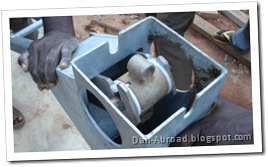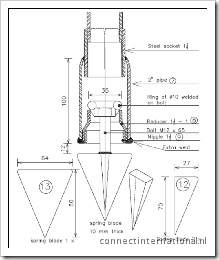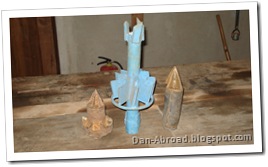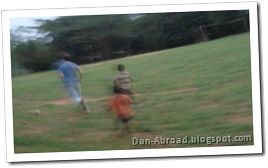
Today, August 20th marks exactly three months for me in Malawi and on Sunday I will be making the four to six hour journey by bus to start EWB’s “re-integration training” in Lilongwe, the capital city. This will likely be my last in-country post and I would like to thank everyone who’s supported me on this journey.
Playing soccer (or bola in Chitonga) here in Malawi is definitely an experience. It’s an even more remarkable community event when I join into play, with all the kids within view or earshot dropping whatever they’re doing and rushing to witness the foreigner flailing around the pitch and tripping over himself, and occasionally my host father standing beside the field shaking his head and smiling.
It is amazing how much soccer goes on without a soccer ball. Kids collect discarded plastic bags and through a careful process melt and tie bits together forming a surprisingly live ball which works perfectly for pick-up matches. Despite this some NGOs spend their time and money handing out soccer balls, and around Mpamba a few carcasses of these free balls can be seen, busted open from hard use. That’s not to say they’re not more durable than the home made balls, those things fall apart all the time! Luckily, with a bit of string, or a knife heated in the fire and a scrap of plastic a quick, cheap repair can be made to the ball and the game continues.
The same could be said for the water sector in Malawi. Many NGOs, and research papers spend time obsessing over the breakdown rates of their, and other organizations pumps. Many of them re-engineer designs every few years in an attempt to make their pump more durable. Though counter-intuitive, this is a bad thing.
No matter how well engineered, eventually every pump will break down and require maintenance of some sort. Just like our two soccer balls, a pump that can be repaired at a low cost, with materials that can be found nearby is ideal. Many NGOs, EWB included put a heavy emphasis on setting up a particular community member as designated to perform maintenance on a number of wells, usually as a business. As well, spare parts need to be available in shops relatively near these communities, such as Trading Centres where they purchase other day-to-day necessities. A pump with breaks down frequently, and is cheap to repair has the potential to drive enough demand to create a profitable supply chain of spare parts, making it possible for shop owners to stock the parts as a viable business. It also means that trained individuals keep their knowledge up to date by doing frequent repairs and maintenance, and business is more profitable for them.
This dichotomy, where well designed pumps lead to bad water programs has taught me to never look at another aid program the same way again. Instead of asking questions about technologies, ask questions about approach, where are decisions in the organization coming from? Does the program convey patronism or empowerment? What evidence is there of sustainability?
After three months in Malawi my footwork on the pitch may not have improved much, but I like to think that my thinking has.
Daniel
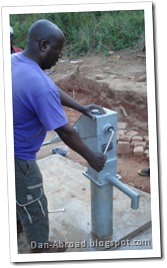 Pump assembly.
Pump assembly.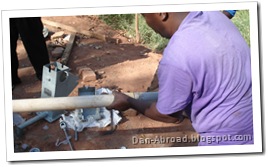 When we last left our well, it had been covered with a concrete pedestal and apron to protect it from contamination, and the “civil works” and washing slab had been built from bricks and concrete. We arrived late in the afternoon in a minibus carrying all the parts required for the Afridev hand-pump and right away set to work.
When we last left our well, it had been covered with a concrete pedestal and apron to protect it from contamination, and the “civil works” and washing slab had been built from bricks and concrete. We arrived late in the afternoon in a minibus carrying all the parts required for the Afridev hand-pump and right away set to work.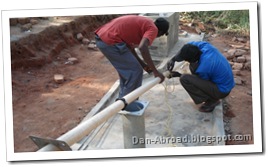 A “foot valve” assembly in the bottom cylinder will keep water inside the pipe that the hand-pump pumps through. This assembly is cemented with PVC solvent cement and a small fire to the PVC pipe. Then, pipe centrizers are slid onto the pipe. These guide the rope holding on to the bottom cylinder, in case it should come unglued. This is slid down the well, and the pipe is measured for length, ensuring that the foot valve is at least one foot above the bottom of the well to stop it from being clogged.
A “foot valve” assembly in the bottom cylinder will keep water inside the pipe that the hand-pump pumps through. This assembly is cemented with PVC solvent cement and a small fire to the PVC pipe. Then, pipe centrizers are slid onto the pipe. These guide the rope holding on to the bottom cylinder, in case it should come unglued. This is slid down the well, and the pipe is measured for length, ensuring that the foot valve is at least one foot above the bottom of the well to stop it from being clogged. 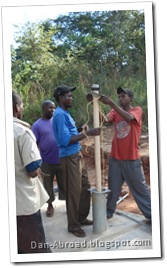 An assembly to hold the pipe in place and centered is cemented to the pipe and it is slid back down the well. The ropes are tightened, and the assembly is bolted to the riser pipe. On top of this the pump casing is also bolted, and the Afridev starts to take shape. Now the plunger, and plunger rod are attached to two more rods and descend down the well. The plunger is a white plastic piece (similar to a foot valve) with a bobbin that creates a valve and is used to raise the water level up the PVC pipe.
An assembly to hold the pipe in place and centered is cemented to the pipe and it is slid back down the well. The ropes are tightened, and the assembly is bolted to the riser pipe. On top of this the pump casing is also bolted, and the Afridev starts to take shape. Now the plunger, and plunger rod are attached to two more rods and descend down the well. The plunger is a white plastic piece (similar to a foot valve) with a bobbin that creates a valve and is used to raise the water level up the PVC pipe.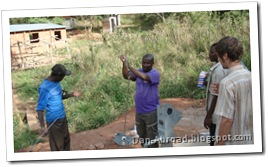
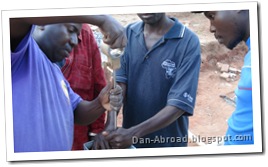 Next, a fulcrum is attached to the top of the rod. This is where the pump handle is attached, allowing a person to move the rod up and down from outside the casing. A pin and bearings are attached to this fulcrum, and the pump handle attaches through the casing to these. If that makes any sense at all, for some clarity hover over the picture.
Next, a fulcrum is attached to the top of the rod. This is where the pump handle is attached, allowing a person to move the rod up and down from outside the casing. A pin and bearings are attached to this fulcrum, and the pump handle attaches through the casing to these. If that makes any sense at all, for some clarity hover over the picture.